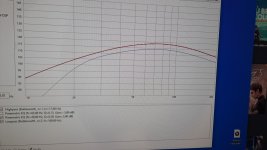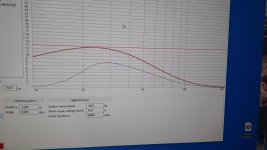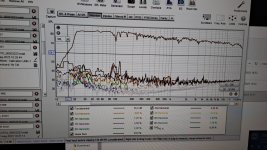Voltage squared divided by resistance/impedance=watts.Doing this, how many watts ill send to the subs?
The impedance of your sealed sub ranges from 6 ohms at 15Hz to ~90 ohms at 50Hz back down to 8 ohms at 100Hz.
35x35=1225/6=204 watts at 15Hz.
35x35=1225/90=13.6 watts at 50Hz.
35x35=1225/8=153 watts at 100Hz.
Applying an inverse curve will change your response shown in post #19 to flat in the pass band.So applying all this changes how my sub response will change between my actual configuration?
Presently your EQ & HP settings are doing something like this:Can I ask you a graph with both configuration, in order to understand the behaviour of the subs?
After applying the inverse EQ curve, HP & LP filters, the response will look pretty much flat, with the -3 dB(BW) or -6dB(LR) point at the set frequency "1" on this graph:
Your present response includes no LP (high cut) so unless you have an LP somewhere else in the chain, the driver's response extends past 2000Hz, as you see in post #1.Also this will reduce the transient response? I like how is fast and punchy right now, so I don't want to loose this characteristics...
Higher frequencies are "faster", 2000Hz is 10 times the speed of 200Hz, which is ten times the speed of 20Hz.
The mid/high frequency transients should come from the top cabinets, if you are used to them coming from the sub, it won't sound as "punchy" when adjusted for flat response.
But it will sound good.
Actually the cut between main speakers and subwoofer is done on the HTPC, and its configured at 90 HzYour present response includes no LP (high cut) so unless you have an LP somewhere else in the chain, the driver's response extends past 2000Hz, as you see in post #1.
Higher frequencies are "faster", 2000Hz is 10 times the speed of 200Hz, which is ten times the speed of 20Hz.
What will change in the perceived sound? I will feel the same as know but with more ultra low frequency? The behaviour of the subs will change? As I said now are really fast in the transient response and very punchyAfter applying the inverse EQ curve, HP & LP filters, the response will look pretty much flat,
If you EQ the subs flat to 15 or 20 Hz, you will perceive low frequency content present in recordings that is lacking without the EQ.What will change in the perceived sound? I will feel the same as know but with more ultra low frequency? The behaviour of the subs will change?
Be aware that the sub woofers response in your room at the listening location may require a very different EQ to flatten the response than a simple inversion. Without measurement, can't say what will work best.
Apply the required EQ, and you will hear/feel the difference, rather than trying to explain it.
I simulated the two sub's with different woofer
one with the tbx as ti have configured right now I my system...
The red one is the lavoce, with a different filters configuration...
What do you think about the kavcie configuration?
If I didn't made any mistake, it seems very good to me, seems that lavoce will push more...
Setting the amp limiter to 45v seems that the x.. will stay into safe zone
what do you think?
one with the tbx as ti have configured right now I my system...
The red one is the lavoce, with a different filters configuration...
What do you think about the kavcie configuration?
If I didn't made any mistake, it seems very good to me, seems that lavoce will push more...
Setting the amp limiter to 45v seems that the x.. will stay into safe zone
what do you think?
Attachments
Did you mean that I should recalibrate with DRC checking the impulse response?Be aware that the sub woofers response in your room at the listening location may require a very different EQ to flatten the response than a simple inversion. Without measurement, can't say what will work best
Pablitho,
Your plots show a red trace with as much as 13mm excursion, a blue trace with only 8mm excursion, both with sharply dropping low frequency response, both lacking in low bass compared to the response at 50-100Hz .
At 20Hz, a reduction of -5dB sounds about half as loud, the EQ settings you chose show a drop of 10-15dB in the octave from 40 to 20Hz. I don't understand why you would EQ a system to that type of response if you want "excellent low bass performance, particularly between 15-30Hz" as you stated in the OP.
I don't know what a "kavcie configuration" is, or what you mean by "recalibrate with DRC checking the impulse response".
I think a good goal for high fidelity subwoofers is to equalize for a flat in room response, equal SPL over the range you desire, regardless of the driver used.
The Xmax of the driver will determine the maximum SPL (sound pressure level) in a sealed box while still within it's linear (undistorted) range.
Using a HP filter and limiter will keep the excursion within Xmax.
Your plots show a red trace with as much as 13mm excursion, a blue trace with only 8mm excursion, both with sharply dropping low frequency response, both lacking in low bass compared to the response at 50-100Hz .
At 20Hz, a reduction of -5dB sounds about half as loud, the EQ settings you chose show a drop of 10-15dB in the octave from 40 to 20Hz. I don't understand why you would EQ a system to that type of response if you want "excellent low bass performance, particularly between 15-30Hz" as you stated in the OP.
I don't know what a "kavcie configuration" is, or what you mean by "recalibrate with DRC checking the impulse response".
I think a good goal for high fidelity subwoofers is to equalize for a flat in room response, equal SPL over the range you desire, regardless of the driver used.
The Xmax of the driver will determine the maximum SPL (sound pressure level) in a sealed box while still within it's linear (undistorted) range.
Using a HP filter and limiter will keep the excursion within Xmax.
Last edited:
it's the xmax escursion of lavoce driver and tbx oneYour plots show a red trace with as much as 13mm excursion, a blue trace with only 8mm
can I send a PM to you?
I don't know what a "kavcie configuration" is
I am guessing he intended to say "Lavoce configuration" but mistyped it.
Can I clarify: are you asking him to apply an inverse curve to flatten both subwoofer responses (red = Lavoce, blue = TBX) so that they are flat over the desired usable range. And then check the xmax of both drivers?
Last edited:
Yes, with a BW24 HP filter to reduce excursion below the desired range.Can I clarify: are you asking him to apply an inverse curve to flatten both subwoofer responses (red = Lavoce, blue = TBX) so that they are flat over the desired usable range. And then check the xmax of both drivers?
"Usable" is a subjective term, which could mean "SPL of at least __ dB at __ frequency, with THD distortion less than__%.
The B&C 18TBX100 has an Xmax of 9mm, Xvar (the magnetic field seen by the voice coil, or the total suspension compliance, or both, drops to less than 50% of their small signal value) of 11mm.
In my subjective listening to B&C drivers, they sound clean (undistorted) with excursion reaching Xvar.
I have no personal experience with Lavoce drivers, though their mechanical formula for Xmax seems close enough to B&C's that comparing 9mm to 13mm Xmax should be "close enough" for determining usable output.
My point all through this thread is there is no reason for Pablitho to chase a few dB more output if he has not first equalized the drivers to the desired goal of "excellent low bass performance, particularly between 15-30Hz".
Each of the suggested drivers will require slightly different EQ settings and power to achieve the goal, but will be well within the acceptable power range of the drivers and amp Pablitho is using in that range.
Art
This is an in-room measurement of my TBX drivers with equalization and room correction at 85dB @ 2,6m (Main listening point). I would like more extension down to 15Hz with less distortion and more headroom, do you think that changing my TBX to Lavoce will help me achieve that goal?
Attachments
Your needs seem to ask for a Long-Throw driver designed to perform at very low frequencies. Pro Drivers are not the right choice for that (they are perfect down to mid-20s but not so great below that)
I think you should be looking at Dayton Aydio Ultimax UM18-22. Double the price but gets the job done.
And keep your B&Cs for a (smaller) midbass box between 30-100Hz
I think you should be looking at Dayton Aydio Ultimax UM18-22. Double the price but gets the job done.
And keep your B&Cs for a (smaller) midbass box between 30-100Hz
If you intend to re-use the cabinets with new drivers, don't forget to check the physical dimensions of the drivers.
Not all 18" speakers are exactly the same size, especially between different brands.
You may have to make mods to the cut-out to fit the new driver.
Not all 18" speakers are exactly the same size, especially between different brands.
You may have to make mods to the cut-out to fit the new driver.
This is exactly what i want to do, but i want to be sure to have a low QTC (Mine actually is 0,55) and a little bit more of extension, without loosing the punch...If you intend to re-use the cabinets with new drivers
So any suggestion will be appreciated, as i said i'm a novice...
Changing from 9mm excursion to 13mm excursion at best increases headroom by 3.2 dB.This is an in-room measurement of my TBX drivers with equalization and room correction at 85dB @ 2,6m (Main listening point). I would like more extension down to 15Hz with less distortion and more headroom, do you think that changing my TBX to Lavoce will help me achieve that goal?
Distortion in your measurement is masked by the room noise since the fundamental level SPL is so low.
Distortion ~10% at low frequencies when reaching Xmax would be in the normally expected range.
Your in room measurement shows only 59.7dB at 15.7Hz due to the BW24 LP filter at 22Hz and lack of EQ boost at 15Hz.
With equalization your drivers should be able to reach over 82dB at 15Hz at 2.6m distance at 9mm excursion, at 59.7dB the excursion is probably under 1mm, 2mm peak to peak.
Sounds like you are looking for more extension while using only a fraction of what your drivers are capable of.
This is like driving an automobile in first gear at 700rpm and noting it only goes 16kpm when it is rated for 160kph.
An increase of 6dB requires doubling excursion.
Without EQ, play a sine wave tone at 15Hz, increase level in 6 dB steps until you see 18mm peak to peak cone movement, compare the level of the harmonics compared to the fundamental, -20dB is 10% distortion.
After you hear what your drivers are capable of, report your findings.
Art
Can i ask you,
On WinISD how can apply this, in order to simulate?
Can you please guide, step by step?
Thank you
On WinISD how can apply this, in order to simulate?
Can you please guide, step by step?
Thank you
WinISD does not simulate distortion or room response.On WinISD how can apply this, in order to simulate?
Can you please guide, step by step?
You have used REW to show your measured frequency response, but have not measured what the excursion of your speaker is, so don't know how much headroom is available.
The sweep test is too fast to see or measure the excursion of your woofer.
Selecting "Generator" allows you to select any frequency, selecting "RTA" allows you to see the response and the harmonics:
In the (non-calibrated) example above using the built in mic on my computer, the fundamental frequency is set to 30.5Hz, "1" level is 56dB, the second harmonic "2" (61Hz) is 38dB (about 12.6% distortion), the third harmonic "3" (91.5Hz) is 35dB (about 9% distortion).
I was suggesting you listen to a sine wave at a fixed frequency, look at your speaker cone and measure it's peak to peak excursion. The TBX driver cone at Xmax moves 18mm peak to peak, near 3/4".
Putting a white dot on the cone makes the excursion easy to see (persistence of vision) looking at the cone from the side, mark a piece of paper with millimeters and compare the movement.
Even as low as 15Hz you will see, hear and feel it can make a lot of sound when the excursion is near Xmax.
You will also probably find all sorts of stuff in your room that makes a lot of sympathetic vibration noise...
Limit the amount of time per test to a few seconds to avoid heat build up.
Art
Last edited:
Hello all,
I am still trying to understand whether the Lavoce will be an improvement over my current subwoofer driver. I have put them both into WinISD. Without EQ, the performance looks the same:

However, when I add EQ to make them both flat, it appears that the Lavoce has a 9dB advantage (Lavoce in red):

It also appears that both drivers are hitting the xmax (13mm for Lavoce, 9mm for my current driver):

I would like to know if I have simulated the scenario correctly and whether the Lavoce will actually give me this improvement or not.
I am still trying to understand whether the Lavoce will be an improvement over my current subwoofer driver. I have put them both into WinISD. Without EQ, the performance looks the same:
However, when I add EQ to make them both flat, it appears that the Lavoce has a 9dB advantage (Lavoce in red):
It also appears that both drivers are hitting the xmax (13mm for Lavoce, 9mm for my current driver):
I would like to know if I have simulated the scenario correctly and whether the Lavoce will actually give me this improvement or not.
- Home
- Loudspeakers
- Subwoofers
- Will this replacement subwoofer work?


